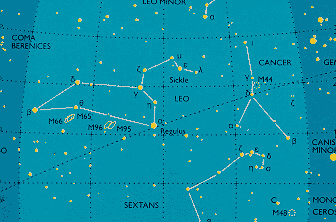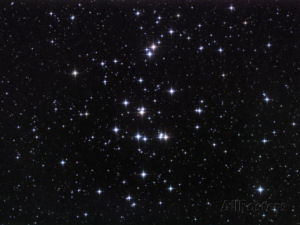
HOME
INTRO
SYMBOLS
ALMANAC
ECONOMY
GEOGRAPHY
STATE MAPS
PEOPLE
FORUM
NEWS
COOL SCHOOLS
STATE QUIZ
STATE LINKS
BOOK STORE
MARKETPLACE
GUESTBOOK
CONTACT US


Tweet
Double click on word for definition.
Utah State Astronomical Symbol

Utah State Astronomical Symbol: Beehive Cluster (M44)
Cancer the Crab Photographs
The Beehive Cluster, also called Praesepe, is a cluster of stars located in the middle of the constellation, Cancer (the crab). It is visible to the naked eye but, of course, better viewed with binoculars or a low power telescope. It was first observed by Galileo Galilei in 1609. French astronomer Charles Messier added it to his catalog of celestial objects as #44 (Messier 44 or M44) in 1769.
The astronomical map to the right shows the relative location of the Beehive. Locate the Cancer constellation on the map. The cluster, labeled M44, is at the middle of the constellation just below, and to the left of, the label "Cancer".
In celebration of Utah's Centennial, celebrated in 1996, two celestial symbols were proposed and supported by the Centennial Committee and Von Del Chamberlain, Director of the Hayden Planetarium, to highlight the state's status as the nation's brightest star.
House Bill No. 140, sponsored by State Representative Marda Dillree proposed that the Beehive Cluster be designated Utah's state astronomical symbol. It also specified that the Dubhe, a star of the constellation Ursa Major (Great Bear) be named the state's official centennial star.

Utah State Astronomical Symbol: Beehive Cluster (M44)
Cancer the Crab Photographs
The star cluster's name aligns nicely with Utah's well-known state emblem, the beehive, signifying such virtues as industry, perseverance, thrift, stability, and self-reliance, all respected by the region's early settlers.
The beehive played, and continues to play, a central roll in Utah's history, stemming from the beliefs and practices of early Mormon settlers.
The beehive was adopted as Utah's official state emblem in 1959. "Industry" was adopted as the state motto in that same year.
The beehive, representing the busy and "industrious" bees that live there, figures prominently on the Great Seal of the State of Utah and, by extension, on the state flag. One might call adoption of the Beehive Cluster a match made in heaven.
"This symbol, composed of a hive of stars, transposes our beehive symbol to a new and grand level as we enter our second century as a group of people living in a place where we can still see, with our own eyes, the beautiful and dim features of the starry universe that has always been of great inspiration to human kind."
That, from a November 3, 1995 document, written by Von Del Chamberlain, offering support for the adoption of the Beehive Cluster as the state's official astronomical symbol.
The Beehive Custer became Utah's state astronomical symbol when Governor Michael Leavitt signed House Bill No. 140 on February 23, 1996.
The content of House Bill No. 140 is offered below.
Enrolled Copy H.B. 140
STATE CENTENNIAL STAR AND
ASTRONOMICAL SYMBOL1996 GENERAL SESSION
STATE OF UTAHSponsor: Marda Dillree
AN ACT RELATING TO DESIGNATING A CENTENNIAL STAR AND ASTRONOMICAL SYMBOL
This act affects sections of Utah Code Annotated 1953 as follows:
ENACTS:
HangingIndent
63-13-11.10 Utah Code Annotated 1953
Be it enacted by the Legislature of the state of Utah:
Section 1. Section 63-13-11.10 is enacted to read:
63-13-11.10 State centennial star and astronomical symbol.
(1) The star, Dubhe, one of the seven bright stars composing the Big Dipper of the constallation Ursa Major, is designated as the centennial star.
(2) The state astronomical symbol is the Beehive Cluster located in the constellation of Cancer the Crab.
Utah Law
The following information was excerpted from the Utah Code, Title 63G, Chapter 1, Part 6, Section 601.
Title 63G General Government
Chapter 1 State Symbols and Designations
Part 6 State Symbols
Section 601 State symbols.
63G-1-601. State symbols.
(1) Utah's state animal is the elk.
(2) Utah's state bird is the sea gull.
(3) Utah's state centennial astronomical symbol is the Beehive Cluster located in the constellation of Cancer the Crab.
(4) Utah's state centennial star is Dubhe, one of the seven bright stars composing the Big Dipper in the constellation Ursa Major.
(5) Utah's state centennial tartan, which honors the first Scots known to have been in Utah and those Utahns of Scottish heritage, shall have a pattern or repeating-half-sett of white-2, blue-6, red-6, blue-4, red-6, green-18, red-6, and white-4 to represent the tartan worn anciently by the Logan and Skene clans, with the addition of a white stripe.
(6) Utah's state cooking pot is the dutch oven.
(7) Utah's state emblem is the beehive.
(8) Utah's state emblem of service and sacrifice of lives lost by members of the military in defense of our freedom is the "Honor and Remember" flag, which consists of:
(a) a red field covering the top two-thirds of the flag;
(b) a white field covering the bottom one-third of the flag, which contains the words "honor" and "remember";
(c) a blue star overlaid by a gold star with a thin white border in the center of the flag spanning the red field and the white field; and
(d) a representation of a folded United States flag beneath the blue and gold stars with three tongues of flame emanating from its top point into the center of the gold star.
(9)Utah's state firearm is the John M. Browning designed M1911 automatic pistol.
(10) Utah's state fish is the Bonneville cutthroat trout.
(11) Utah's state flower is the sego lily.
(12) Utah's state folk dance is the square dance, the folk dance that is called, cued, or prompted to the dancers and includes squares, rounds, clogging, contra, line, and heritage dances.
(13) Utah's state fossil is the Allosaurus.
(14) Utah's state fruit is the cherry.
(15) Utah's state vegetable is the Spanish sweet onion.
(16) Utah's historic state vegetable is the sugar beet.
(17) Utah's state gem is topaz, as is prominently found in the Thomas Mountain Range in Juab County, Utah.
(18) Utah's state grass is Indian rice grass.
(19) Utah's state hymn is "Utah We Love Thee" by Evan Stephens.
(20) Utah's state insect is the honeybee.
(21) Utah's state mineral is copper.
(22) Utah's state motto is "Industry."
(23) Utah's state railroad museum is Ogden Union Station.
(24) Utah's state rock is coal.
(25) Utah's state song is "Utah This is the Place" by Sam and Gary Francis.
(26) Utah's state tree is the quaking aspen.
(27) Utah's state winter sports are skiing and snowboarding.
Amended by Chapter 46, 2014 General Session
Sources...
"63G-1-601. State Symbols." Utah Code. Utah State Legislature, 13 May 2014. Web. 18 Apr. 2015.
Chamberlain, Von Del. "Proposal for Two Utah State Symbols in the Sky." Utah Legislature. State of Utah, 2 Nov. 1995. Web. 17 Apr. 2015.
Dillree, Marda. "Search Bill Drafting & Research Files: House Bill No. 140."Utah Legislature. State of Utah, 23 Feb. 1996. Web. 17 Apr. 2015.
Shankle, George Earlie. State Names, Flags, Seals, Songs, Birds, Flowers, and Other Symbols. Irvine, Calif.: Reprint Services Corp, Revised edition, 1971.
Shearer, Benjamin F. and Barbara S. State Names, Seals, Flags and Symbols: A Historical Guide Third Edition, Revised and Expanded. Westport, Conn: Greenwood Press, 3 Sub edition, 2001.
Additional Information
Utah State Astronomical Symbol - Beehive Cluster: From "Pioneer" Utah's Online Library: Utah State Library Division.
Beehive: 1,000 stars in Cancer: EarthSky.org publishing the high-quality digital media for people seeking scientifically accurate and compelling information about the Earth, outer space and the human world.
Astronomy Picture of the Day: M44: The Beehive Cluster: National Aeronautics and Space Administration (NASA).
M44 (Praesepe or Beehive Cluster) in Cancer: Backyard astronomy from Math Heijen, the Netherlands.
More symbols & emblems: Complete list of official Utah state symbols from NETSTATE.COM.
Roth Ritter Wall Peel Wall Art Print entitled The Beehive Cluster: Amazon Art Print featuring Utah's Astronomical Symbol.

